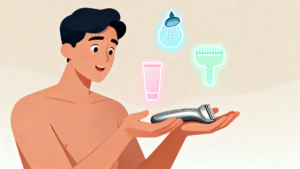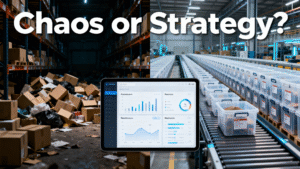The practice of grooming for athletes is a long-standing ritual, seen everywhere from the hairless bodies of Olympic swimmers to the smooth legs of Tour de France cyclists. For the amateur athlete and fitness enthusiast, this raises a compelling question: Is this just about aesthetics and tradition, or does it provide a real, measurable improvement in athletic performance? This guide will dive into the science, psychology, and practical realities to separate fact from fiction.
The answer is more complex and fascinating than a simple yes or no. The benefits are real, but they span across physics, physiology, and psychology. This guide will dive into the science and the practical realities behind performance grooming. For athletes, this is a deep dive into gaining a competitive edge. For brands, understanding the true motivations of this high-performance niche is the key to designing products and marketing messages that genuinely resonate.
1. The Hydrodynamic Case: Swimmers Shaving for a Better “Feel”
The most famous example of grooming for athletes is in competitive swimming. For years, the assumption was that shaving was all about reducing drag in the water.
- The Science: While removing hair does reduce body friction and hydrodynamic drag, studies have shown this physical advantage is incredibly small—often measured in just hundredths of a second. The real, scientifically-backed benefit is neurological. Shaving exfoliates the outer layer of dead skin, dramatically increasing the sensitivity of the nerve endings on the skin’s surface. This gives the swimmer a much greater “feel” for the water, allowing them to make micro-adjustments to their technique that improve efficiency and power.
- The Verdict: Yes, it improves performance. While the drag reduction is minimal, the heightened sensory feedback and the immense psychological boost of feeling sleek, fast, and “race-ready” provide a tangible competitive advantage.

2. The Aero Argument: Cycling Aerodynamics and Practical Realities
The sight of a cyclist with hairy legs is rare in the professional peloton. The primary argument is that smooth legs are more aerodynamic.
- The Science: Unlike the swimming debate, wind tunnel tests have provided conclusive evidence here. Famously, a test conducted by Specialized Bicycles found that shaving legs could save a rider anywhere from 50 to 82 seconds over a 40km time trial. In a sport where races are won by fractions of a second, this is a massive, undeniable gain.
- The Practical Side: For most amateur cyclists, however, the main reasons are more practical. In the unfortunate event of a crash, cleaning road rash on shaved skin is significantly easier and less painful. Furthermore, applying athletic tape or getting a post-ride sports massage is far more effective and comfortable on smooth skin.
- The Verdict: Yes, it measurably improves performance by reducing wind resistance. But for the everyday cyclist, the practical benefits of easier wound care and recovery are often the more compelling reasons.

3. The Friction Fighter: How Grooming Helps Prevent Chafing
For runners, triathletes, and anyone involved in endurance sports, the biggest enemy isn’t always the clock—it’s the painful, debilitating effect of chafing.
- The Science: Chafing is caused by repeated friction between skin, clothing, and moisture (sweat). Hair in areas like the chest, underarms, and groin can trap sweat and salt crystals, creating a sandpaper-like effect that exacerbates irritation. Removing hair from these key areas creates a smoother surface, reduces moisture-trapping, and can significantly decrease the risk of painful chafing during a long run or ride.
- The Verdict: Absolutely. While it may not make you faster in terms of pure speed, preventing a painful chafe is critical for endurance. An athlete who can run comfortably for three hours will always perform better than one who has to stop at hour two because of raw, irritated skin.
The B2B Insight: This is where product design is paramount. Athletes need to groom areas that are difficult to see and reach. An ergonomic design for reach is not a luxury; it’s a necessity. Furthermore, because an athlete’s skin is already under stress, skin-safe technology is crucial to prevent further irritation.

4. Beyond the Clock: The Other Performance Benefits
The advantages of grooming for athletes go beyond measurable time savings. Here’s a summary of the other key benefits that contribute to a holistic view of athletic performance.
| Benefit Category | Specific Advantage | Relevant For | B2B Product Angle |
| Psychological | Feeling “fast,” “sleek,” and “professional.” The mental boost of preparation. | All athletes | Marketing should focus on confidence and feeling “race-ready.” |
| Practical (Hygiene) | Easier to clean sweat and dirt post-workout. Less odor retention. | All athletes, especially in hot climates. | Promote easy-to-clean, antibacterial, and waterproof body groomer devices. |
| Practical (Recovery) | Makes applying athletic tape, foam rolling, and sports massages easier and more effective. | Cyclists, runners, bodybuilders. | A great marketing angle for brands to partner with physios or massage therapists. |

Conclusion: It’s a Real, Holistic Advantage
So, does grooming for athletes actually improve performance? The answer is a definitive yes.
The measurable gains in swimming and cycling, while small, are significant enough to be standard practice at the elite level. However, for the vast majority of athletes, the most powerful benefits are found in improved comfort (preventing chafing), enhanced recovery (easier massages and wound care), and the undeniable psychological edge that comes from feeling prepared, professional, and ready to perform.
The Final B2B Takeaway: Brands that want to capture the lucrative athlete market should evolve their marketing beyond just “speed.” The winning niche marketing strategy is to communicate a holistic performance message: comfort, hygiene, recovery, and confidence. This requires a true performance grooming tool—one that is versatile, waterproof, ergonomic, and, above all, exceptionally gentle on skin that is already pushed to its limits.





